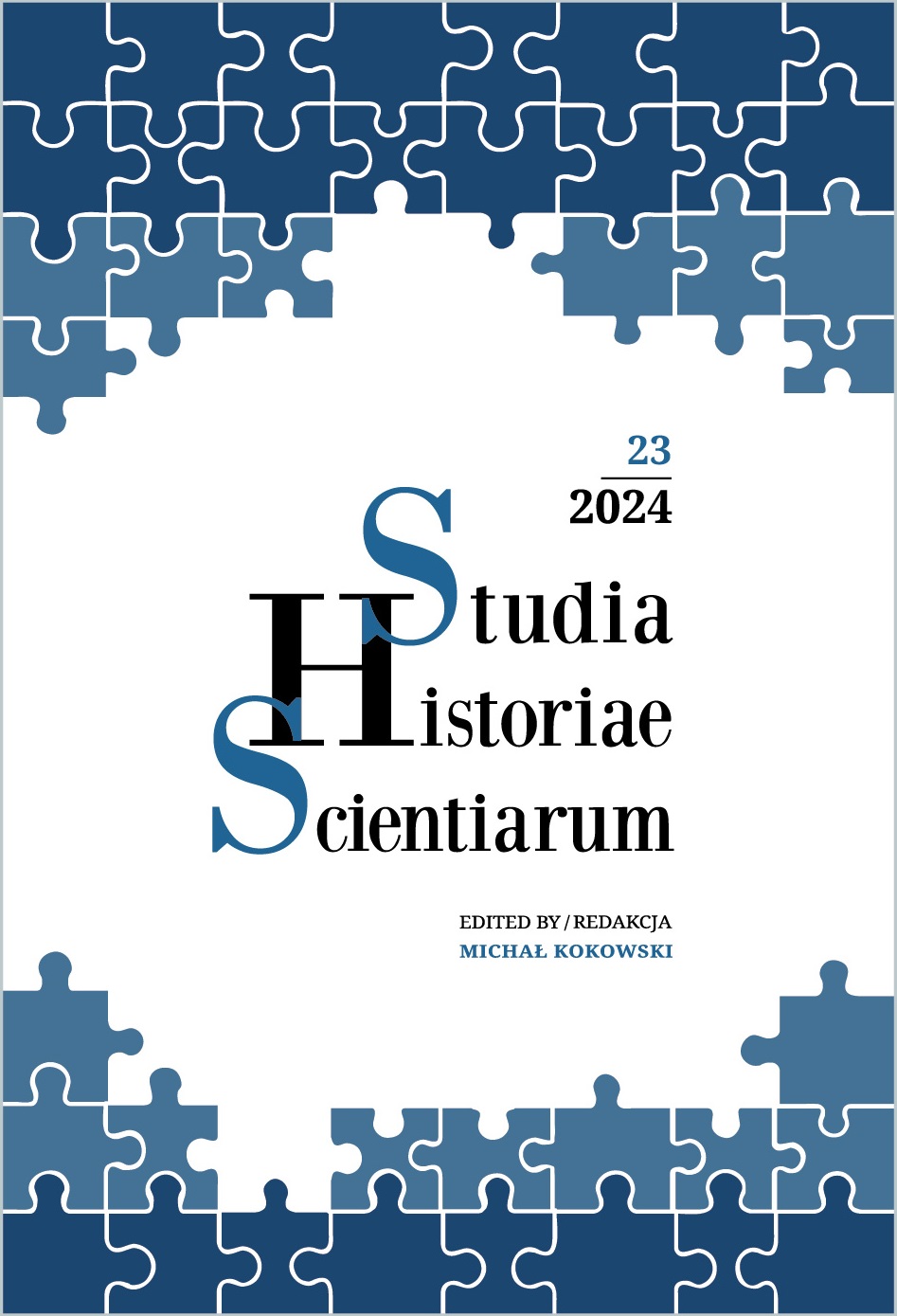Copernicus and Copernicans: Galileo, Kepler, Bruno
DOI:
https://doi.org/10.4467/2543702XSHS.24.004.19577Keywords:
Copernicus, Giordano Bruno, geocentrism, heliocentrism, anthropocentrismAbstract
Copernicus claimed the Earth revolves around itself and the Sun. He also claimed that the universe was finite and that no intelligent life existed on other planets. Galileo and Kepler shared these claims; therefore, they deserve to be called Copernicans. But what about Giordano Bruno? He adopted Hermetic philosophy and opposed Copernicus’s mathematical (geometric) method; he also claimed, unlike Copernicus, that the universe was infinite and that there were intelligent life forms on other planets. So, can we define Bruno and those who thought like him as Copernicans? Ernan McMullin answers this question in the negative. In this paper, I will argue that the differences between Bruno and Copernicus mentioned by McMullin cannot be used as criteria for claiming that Bruno and others who thought like him were not Copernicans; instead, I argue that believing the Earth rotates around itself and the Sun should be considered sufficient to call someone a Copernican.
References
Bacon, Francis 1861: “Descriptio Globi Intellectualis”. In The Works of Francis Bacon: Translations of the philosophical Works, Vol. 5, eds. James Spedding and et al. London: Longman & Co.
Bergerac, Cyrano de 2016: The Other World: The Comical History of the States and Empires of the World of the Moon. Trans. Archibald Lovell. CreateSpace Independent Publishing Platform.
Brake, Mark 2013: Alien life imagined: Communicating the Science and Culture of Astrobiology. New York: Cambridge University Press.
Bruno, Giordano 2018: The Ash Wednesday Supper: A New Translation. Trans. Hilary Gatti.Toronto: University of Toronto Press.
Campanella, Thomas 1994: A Defense of Galileo: The Mathematician from Florence. Trans. Richard J. Blackwell. Notre Dame: University of Notre Dame Press.
Carré, Marie-Rose 1974: “A Man between Two Worlds: Pierre Borel and His Discours nouveau prouvant la pluralité desmondes of 1657”. Isis, 65 (3), 322–335.
Copernicus, Nicolaus 1995: On the Revolutions of Heavenly Spheres. Trans. Charles Glenn Wallis. New York: Prometheus Books.
Danielson, Dennis R. 2001: “The Great Copernican Cliché”. American Journal of Physics, 69(10), 1029–1035.
Danielson, Dennis R. 2014: Paradise Lost and the Cosmological Revolution. New York: Cambridge University Press.
Dick, Steven J. 1982: Plurality of Worlds: The Origins of the Extraterrestrial Life Debate from Democritus to Kant. Cambridge: Cambridge University Press.
Drake, Stillman 1975: “Copernicanism in Bruno, Kepler, and Galileo”. Vistas in Astronomy, 17, 177–192.
Duhem, Pierre 1987: Medieval Cosmology: Theories of Infinity, Place, Time, Void, and the Plurality of Worlds. Trans. Roger Ariew. Chicago: The University of Chicago Press.
Gatti, Hilary 2004: “Giordano Bruno’s Copernican Diagrams”. Filozofski vestnik, 25(2), 25–50.
Granada, Miguel A. 2004: “Aristotle, Copernicus, Bruno: Centrality, the Principle of Movement and the Extension of the Universe”. Studies in History and Philosophy of Science, 35, 91–114.
Guthke, Karl S. 1990: The Last Frontier: Imagining Other Worlds from the Copernican Revolution to Modern Science Fiction. Trans. Helen Atkins. Ithaca: Cornell University Press.
Guthke, Karl S. 2003: “Nightmare and Utopia: Extraterrestrial Worlds from Galileo to Goethe”. Early Science and Medicine, 8(3), 173–195.
Hallyn, Fernand 1990: The Poetic Structure of the World: Copernicus and Kepler. Trans. Donald M. Leslie. New York: Zone Books.
Harries, Karsten 2001: Infinity and Perspective. Cambridge: The MIT Press.
Huygens, Christiaan 2018: Cosmotheoros: Or Conjectures Concerning the Planetary Worlds, and Their Inhabitants. Creative Media Partners. (This translation was first published in 1689).
Johnson, Francis R. & Sanford V. Larkey 1934: “Thomas Digges, the Copernican System, and the Idea of the Infinity of the Universe in 1576”. The Huntington Library Bulletin, 5, 69–117.
Kant, Immanuel 2008: Universal Natural History and Theory of the Heavens. Trans. Ian Johnston. Arlington, Virginia: Richer Resources Publications.
Kepler, Johannes 2002: Harmonies of the World, Book Five. Ed. Stephen Hawking. Philadelphia: Running Press.
Kirschner, Stefan & Andreas Kühne 2015: “The Decline of Medieval Disputation Culture and the ‘Wittenberg Interpretation of the Copernican Theory’”. In The Making of Copernicus: Early Modern Transformations of the Scientist and his Science. (eds. Wolfgang Neuber, et al.). Leiden: Brill.
Kokowski, Michał 2023: Dlaczego nadal interesuje nas Mikołaj Kopernik (1473–1543)? 550-lecie urodzin Mikołaja Kopernika i 150-lecie pierwszego publicznego posiedzenia Akademii Umiejętności w Krakowie. Studia Historiae Scientiarum 23, pp. 71–147. DOI: 10.4467/2543702XSHS.23.003.17694.
Koyré, Alexandre 1957: From the Closed World to the Infinite Universe. Baltimore: The Johns Hopkins Press.
Kuhn, Thomas 2003: The Copernican Revolution: Planetary Astronomy in the Development of Western Thought. Cambridge: Harvard University Press.
Leopardi, Giacomo 1982: “The Copernicus”. In Essays and Dialogues. Trans. Giovanni Cecchetti. Berkeley: University of California Press.
Lovejoy, Arthur O. 2001: The Great Chain of Being: A Study of the History of an Idea. Cambridge: Harvard University Press.
McMullin, Ernan 1987: “Bruno and Copernicus”. Isis, 78(1), 55–74.
Nicolson, Marjorie 1939: “English Almanacs and the ”. Annals of Science, 4(1), 1–33.
Omodeo, Pietro Daniel 2014: Copernicus in the Cultural Debates of the Renaissance: Reception, Legacy, Transformation. Leiden: Brill.
Palter, Robert 1964: “Copernicanism, Old and New”. The Monist, 48/2, 143–184.
Rossi, Paolo 1972: “Nobility of Man and Plurality of Worlds”. In Science, Medicine and Society in the Renaissance: Essays to honor Walter Pagel, Volume Two. Ed. Allen G. Debus, 131–162. London: Heinemann.
Rossini, Paolo 2020: “Changing Conceptions of Mathematics and Infinity in Giordano Bruno’s Vernacular and Latin Works”. Science in Context, 33, 251–271.
Rubenstein, Mary-Jane 2014: Worlds Without End: The Many Lives of the Multiverse. New York: Columbia University Press.
Westman, Robert S. 1975: “The Melanchthon Circle, Rheticus, and the Wittenberg Interpretation of the Copernican Theory”. Isis, 66(2), 165–193.
Westman, Robert S. 2019: “How Did Copernicus Become a Copernican?”. Isis, 110(2), 296–301.
Wilkins, John 2018: The Discovery of a World in the Moone. Frankfurt am Main: Outlook.





























